|
 |
| |
|
|
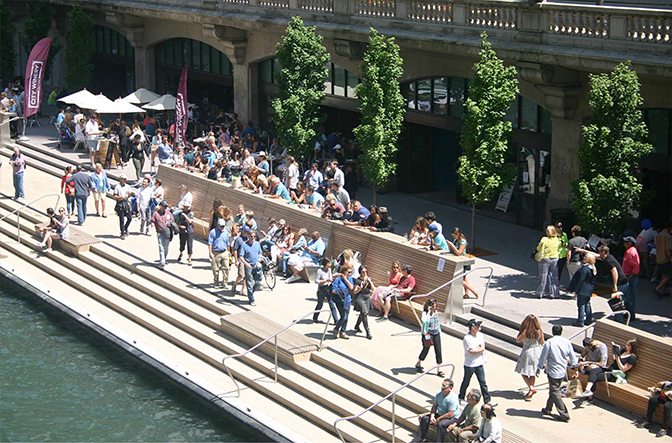 |
|
The Main Branch of the Chicago River has a long and storied history. Once a meandering marshy stream, the river first became an engineered channel to support the industrial transformation of the city. Following the famed reversal of the river, in which the city reversed the flow to improve sanitation, architect and urban planner Daniel Burnham introduced a new civic vision of riverside promenades with the addition of the Wacker Drive viaduct. Over the last decade, the role of the river has been evolving with the Chicago Riverwalk—an initiative to reclaim the Chicago River for the ecological, recreational and economic benefit of the city. The goal of embracing the river as a recreational amenity seemed impossible years ago given the river's high levels of pollution. But recent improvements in river water quality and the increased intensity of public recreational use signal growing life along the river, demanding new connections to the water's edge. Accordingly, the client developed an initial Phase 1, a segment that includes Veteran’s Memorial Plaza and the Bridgehouse Museum Plaza. The Phase 1 project was an immediate success. The Chicago Riverwalk was beginning to become a destination space. |
|
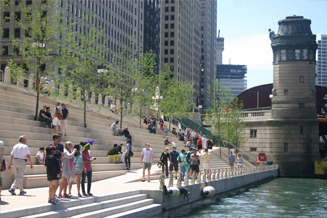
|
|
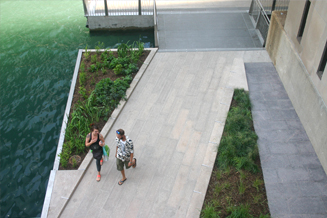 |
|
In 2012, a new leadership team headed by Sasaki and Carol Ross Barney, the architect of Phase 1, joined with local landscape architect Jacobs/Ryan Associates and Alfred Benesch, and supported by a host of technical consultants, was tasked with completing the vision for Phases 2 and 3: five blocks between State Street and Franklin Street. Building off the previous studies of the river, the team’s plans continue a pedestrian connection along the river's south bank between the lake and the river’s confluence.
Technically challenging, the design team had to work within a permit-mandated 25-foot-wide build-out area and negotiate a series of under-bridge connections between blocks, while accounting for the river’s annual flood dynamics of nearly seven vertical feet. Turning these challenges into opportunities, the team imagined new ways of thinking about this linear park. Rather than a path composed of 90-degree turns, the team envisioned the path as a more independent system—one that would drive a series of new programmatic connections to the river and enable to City to derive new sources of revenue.
|
|
With new connections that enrich and diversify life along the river, each block takes on the form and program of a different river-based typology. These spaces include: The Marina Plaza -- Restaurants and outdoor seating provide views of vibrant life on the water, and enable mooring of boat. The Cove -- Outdoor seating and docking for human-powered crafts provide physical connections to the water through recreation. The River Theater -- A sculptural staircase linking Upper Wacker and the Riverwalk offers pedestrian connectivity to the water’s edge and seating, while trees provide greenery and shade and stormwater is cleaned and recycled for irrigation. The Water Plaza -- A water feature offers an opportunity for children and families to engage with water at the river’s edge. The Jetty -- A series of piers and floating wetland gardens offers an interactive learning environment about the ecology of the river, including opportunities for fishing and identifying native plants, while underwater habitat enhancements make a better life for river fish. The final link, between Franklin and Lake Streets, serves as an experimental program space. The city is continuing to explore possibilities for how the room can be developed. |
|
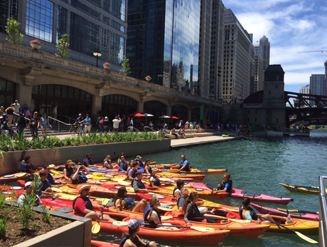 |
|
As a new connected path system, the Chicago Riverwalk design provides both continuity and variety for visitors and tourists. The distinct programs and forms of each typological space allow for diverse experiences on the river. At the same time, design materials, details, and repeated forms provide visual cohesion along the entire length of the project. Paving, for instance, mirrors the contrasts of the existing context: A refined cut granite follows the elegant Beaux-Arts Wacker viaduct and bridgehouse architecture, while pre-cast plank pavers flank the lower elevations and underside of the exposed steel bridges. New integrated lighting provides safety and visual stimulation to attract visitors during the nighttime hours. |
|
| Large caliper trees and native plants characterize the project's plantings. The Marina has Armstrong Maples and Kindred Spirit Oaks, under-planted with shrubs and perennials. The Cove has beach grass and inundation tolerant plants at riverside, with River Birch and ferns in the corners. Perfection Honeylocusts grace the stairs at The River Theater. The Water Plaza is flanked by two Bald Cypress trees, one on each end, and Corneliancherry Dogwood, with shrubs and perennials. At The Jetty, there are three levels of native plantings. There are inundation tolerant grasses and forbs along the path. In the floating islands, there are emergent plants that have their roots in the water. And in the nooks between the jetties are submergent hardy Water Lilies, underwater on a shelf. |
|
The 100 million dollar budget, made possible by federal loan, has spurred eight billion dollars in local area investment per one City source, and is being paid back through developed retail revenue. With both phases open in Fall 2016, the immediate overwhelming success of the project is not only transformative for the City, it is also beginning to garner awards (AIA) and articles (Topos and Tribune), highlighting this landscape's relevance to urban design.
Client: Chicago Department of Transportation; Prime Consultant: Sasaki Associates; Architect: Ross Barney Architects; Engineers: Alfred E Benesch |
|
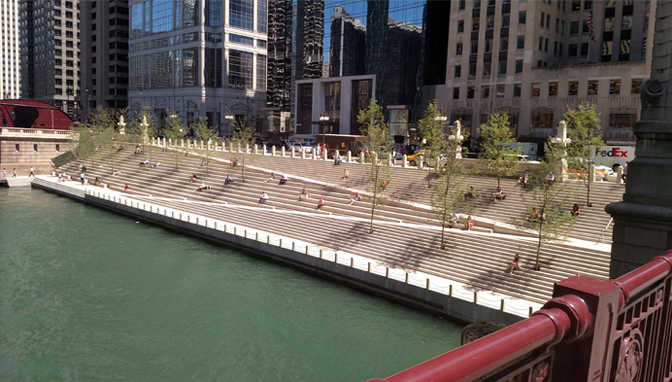 |
|
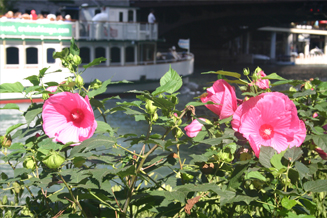 |
|
Topos 94 City Visions featured the project on its cover
World Architecture gave the project a full spread in the article, “Sasaki and Ross Barney Architects complete Chicago Riverwalk”
http://worldlandscapearchitect.com/sasaki-and-ross-barney-architects-complete-chicago-riverwalk/
It has been reviewed by Curbed in the article “Chicago’s new Riverwalk offers a vision of the future of urban parks”
http://www.curbed.com/2016/10/24/13382868/chicago-riverwalk-landscape-architect-urbanism-design
It has appeared in Civil Engineering in the article, “The Chicago river takes center stage in third phase of riverwalk project”
And it is about to appear in Landscape Architecture, the premier magazine for the profession.
The Riverwalk has its own website: https://www.chicagoriverwalk.us/
It also has its own Facebook page and Wikipedia page, and gets a 4.5 star review on Trip Advisor. |
|
The Riverwalk has received the following awards:
- International Downtown Association, Pinnacle Award – Public Space Category
- Chicago Building Congress Merit Awards, Honor Award for Infrastructure Construction, Phase 2
- Illuminating Engineering Society International Illumination Design Award of Excellence, Outdoor Lighting Design, Phase 2
- Chicago River Blue Awards, Silver Ribbon, Phase 2
- Fast Company Innovation by Design Awards, Finalist — Spaces, Places, and Cities Category, Phase 2
- American Institute of Architects, Chicago Chapter, Design Excellence Award, Phase 2
- The Waterfront Center Excellence on the Waterfront Awards, Honor Award — Park/Walkway/Recreational Category, Phase 2
- The Architect’s Newspaper, Best of Design Awards, Phase 2
We predict there are more awards to come. |
|
|
|